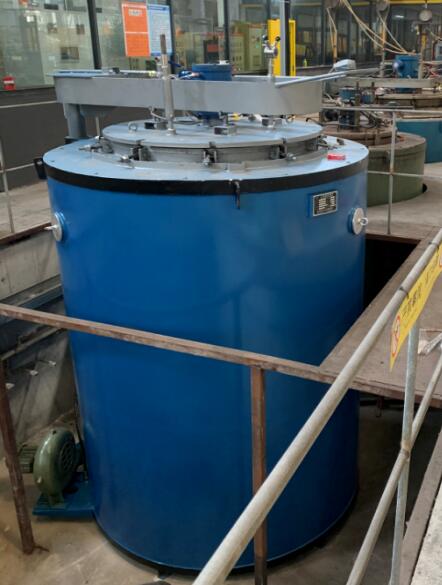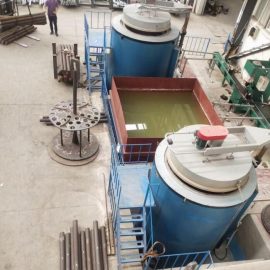Automotive Crankshaft Nitriding Technology Process
In order to improve the fatigue strength of crankshaft, many crankshaft production plants have adopted the gas soft nitriding technology (gas soft nitriding is a chemical heat treatment process developed from liquid soft nitriding, and its essence is low temperature carbonitriding based on nitriding.It is characterized by low temperature, short time, small deformation of workpiece, stable quality, not limited by steel, can significantly improve the parts of the wear resistance, fatigue strength, anti-bite, anti-scratch and other properties, but also can solve the liquid soft nitriding in the toxic problem, to avoid public harm, so the working conditions are good.In addition, the equipment and operation are simple and easy to promote.The basic principle is that the principle of gas soft nitriding is to produce 2C0→[C]+C02(carburizing) and 2NH3→2N]+3H2(nitriding) reactions in the atmosphere of 530℃ ~ 580℃, to form nitrides or carbonitrides on the surface of steel.
At present, the typical crankshaft material used in domestic production is 45 steel and 42CrMoTi crankshaft gas soft nitriding, which is similar to the treatment of other soft nitriding parts. The nitriding process generally goes through five stages, including pre-cleaning, heating, heat preservation, cooling and post-cleaning, including the furnace.Different manufacturers vary slightly in the process of gas soft nitriding.

1. Cleaning process
The parts to be treated should be cleaned before loading the furnace to make the surface of the parts clean and oil-free. At present, the main cleaning methods used are as follows: high-temperature steam washing and cleaning agent washing and then high-temperature steam washing, automatic cleaning machine cleaning, gasoline scrubbing.Cleaning quality will directly affect the processing quality of crankshaft and prolong the processing cycle.If the crankshaft surface dirty treatment of the crankshaft surface attached to a lot of carbon black, both affect the appearance of the product and affect the quality of the product.After the improvement of the cleaning process, the quality of the external cleaning is greatly improved. According to practical experience, the surface cleaning is easy to form a continuous compound layer with uniform thickness than the head, otherwise, it is difficult to form a continuous and uniform compound layer with uniform thickness.In the case of gas soft nitriding, the compound layer has a great contribution to the hardness, wear resistance and fatigue resistance.The third method in this paper is a workaround method when the production conditions are not available, which is only applicable to small-scale cleaning.
2. Pre-oxidation process
In order to ensure the comprehensive requirements of the performance of parts, before the gas soft nitriding generally need to be pre-heat treatment, gas soft nitriding preheating temperature is generally 400~490℃, heat preservation for 1hour or so, remove the workpiece surface oil, grease, and the formation of a layer of oxide on the surface, make (alloy) nitride slowly formed, make the deep more uniform.According to the degree of deformation of parts, a proper heating rate should be selected and the microstructure should be fully homogenized by pre-heat treatment.
3. Soft nitriding process
The process parameters of gas soft nitriding are generally as follows: the average heating rate is 100℃/h;The holding temperature is 540~570℃;The holding time was 3~4hours.
(1) The selection range and control of soft nitriding temperature
Gas soft nitriding (low temperature carbonitriding) is often used for carbon steel or cast iron or low alloy steels.A great deal of practice shows that the hardness and permeability of the nitride layer are related to the extreme value of temperature, time and concentration.In the ternary phase diagram of Fe, N and C, the allotropic transition point decreases slightly, and its isothermal cross section decreases to about 575℃.When the temperature is below 575℃, the permeability layer and the hardness speed decrease with the increase of the temperature. When the temperature is above 600℃, the permeability layer almost completely disappears. In order to have a better effect of carbonitriding, the control temperature of gas soft nitriding is generally 570℃(higher than the ternary eutectoid point).Nitrogen-containing austenite is formed in the surface layer, and nitrogen-containing martensite is formed when fast cooling, so that the surface forms a high hardness, so fast cooling is easy to be used in soft nitriding.In the early stage of soft nitridation (about 3hour), it is a strong permeability stage, forming a high nitrogen potential phase in the surface layer, increasing the permeability rate, and then entering the diffusion stage, reducing the surface nitrogen content and reducing the brittleness.
(2) Proportional flow rate of gas in soft nitriding process
When strong infiltration, the ratio of NH3, C02 and N2 is generally 55:5:40, and the ventilation is generally the volume of the furnace
1.5 to 2 times.Appropriate increase of NH3 content, can improve the permeability layer: appropriate increase of C02 content, can mention the workpiece surface hardness (if measured by HV10, the influence of the surface hardness factors are nitrogen matrix hardness, diffusion layer depth, white layer hardness.45 steel requires matrix hardness before nitrogen >200 HBW).The ratio of NH3, C02 and N2 in diffusion is generally 40:5:55, and the ventilation volume is generally 1~1.5 times of the furnace volume.
The hydrogen content in the furnace: the hydrogen content in the strong permeability area is above 10%~18% (the hydrogen content in the new furnace is low);The hydrogen content in the diffusion zone is above 8%~13% (the hydrogen content in the new furnace is low)
Baking furnace process: each new furnace before loading the workpiece should be empty infiltration time of 6~12hours, hydrogen content reaches more than 10%. After a period of continuous use (3 months), the new furnace should be emptised. The temperature is 600℃ for more than 12hours, only a small amount of nitrogen, maintain the furnace pressure (240~300Pa) to obtain the best hardness and permeability layer.
4. Cooling process after soft nitriding
In order to make the crankshaft have a better effect of carbon and nitriding, the control temperature of gas soft nitriding is generally 570℃(higher than the ternary eutectoid point) in the surface to form nitrogen-containing austenite, nitriding after the formation of rapid cooling of nitrogen-containing martensite, so that the surface quickly formed a high hardness, so soft nitriding easy to use fast cooling.An equipment manufacturer adopts oil cooling for continuous soft nitriding cooling. Its equipment adopts fully automatic control. It is directly pushed from the nitriding furnace body to the oil cooling lifting platform by the pushing mechanism and automatically lowered to the oil groove for cooling.Dual stirring cooling is used for cooling. Generally, quick stirring is 5~6min, while 1300r/ Mine slow stirring is about 10min and 750r/min.Drizzle oil for about 5min.After cooling, the size of the crankshaft will produce deformation. As long as the deformation is treated well by aging (2~4h), the uniform temperature rise can ensure that the deformation is small. The axial runout control of the nitriding crankshaft in Weifang Diesel Engine Factory is better.
5. Cleaning process after nitriding
After processing the parts should be cleaned to make the surface of the parts clean and oil-free. The main cleaning methods used at present are as follows: high-temperature steam washing and cleaning agent washing and then high-temperature steam washing;Automatic cleaning machine cleaning;Gasoline scrub.

Gas Trolley Heat Treatment Furnace For Tungsten And Molybdenum Products QPQ Salt Bath Liquid Nitriding Process And Quality Control 40Cr Steel Quenching And Tempering Treatment Process


Contact us
Your email address will not be published. Required fields are marked *